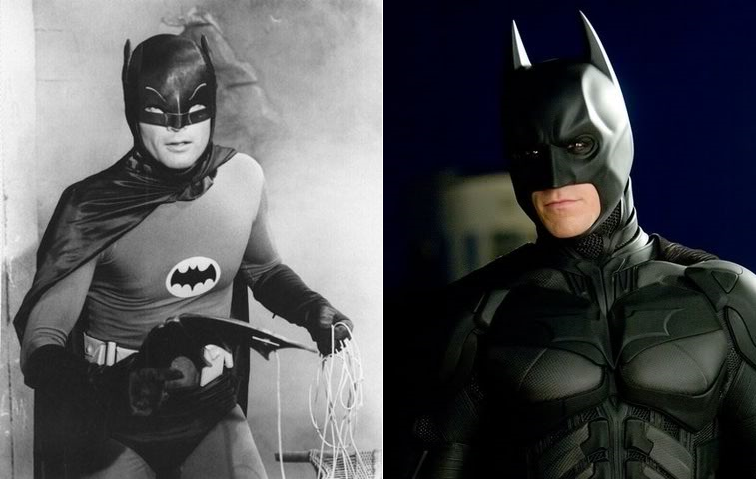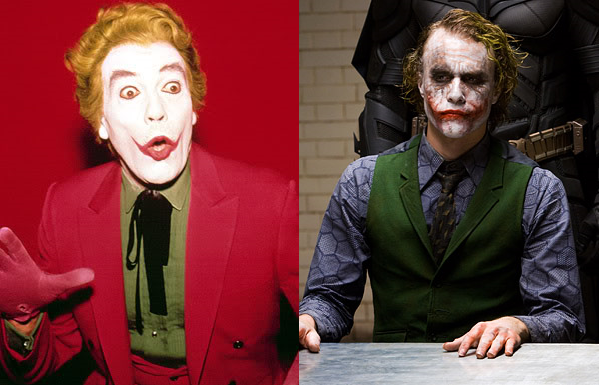Thanks to The Hub, I've been treated to an episode of the brilliant 1960s Batman TV show just about every night of the week. It's been a long, long time since I've seen many of these stories, and I'm positively delighted to experience them once again. Being a tenth-level geek, however, has the back of my mind spinning, weaving together connections between the campy pop series and later Bat-lore. The inspiration it provided the Tim Burton and Joel Schumacher films seems readily apparent-- Batman Returns borrows a plot from a Penguin episode, Schwarzenegger's Mr. Freeze may as well be Otto Preminger's, etc-- but what could 60s Batman possibly have in common with the grim avenger from the current Bat-flicks? Why, quite a bit, actually.
You see, I've determined that Christopher Nolan's Bat-films take place in the same continuity as the Adam West-led series. Yes-- they are prequels, and I can prove it!
The first thing a nerdy obsessive like you or me might notice about Batman '66, as it shall hence be called, is that it can't be bothered with a whole lot of backstory. As the series begins, Batman and Robin are already in business and battling a regular rotation of rogues, almost all of whom already exist as known quantities within the Bat-universe, even characters who were created wholesale for the TV series, like King Tut and the Bookworm. Conversely, the animated series from the '90s spent a lot of time introducing its villains, aside from those that carried over from the Burton films. The '60s villains already exist, independent of the show, a priori style, having spent quite a bit of time building their reputations before we ever got a peek into their universe.
Therefore, the history of Bruce Wayne, Dick Grayson, Batman, Robin, Gotham City, and all the rest remains unexplored in Batman '66. Bruce very rarely mentions his parents' tragic deaths at the hands of a criminal, and no explanation is given for Dick Grayson and Harriet Cooper's presence in Stately Wayne Manor-- at least, not in the heaping pile of episodes I've watched over these past several months, aside from continual references to the young master Grayson as Bruce Wayne's "youthful ward". Could Batman's origins be explained somewhere else, say, in films directed by Christopher Nolan, four decades later? Indeed! It seems Nolan has made an effort to adhere to the continuity of Adam West.
As we've seen, Nolan's Bruce Wayne, as played by Christian Bale, loses his parents at a young age, receives an Ivy League education (or most of one), develops worldly experience through his travels, undergoes ninja training to develop uber-competent fighting skills, and returns to Gotham as a vengeful creature of the night. He forges an alliance with James Gordon, listens to sage advice from butler and father figure Alfred, accrues a large amount of ludicrous technology he puts to use in his war on crime, and makes life miserable for any mobsters or ninja assassins guilds that cause trouble in Gotham City. Sound familiar?
"But," you cry, starting a sentence with a conjunction, which is totally bad form, "Bale's Batman is a grim, gritty, gravelly-voiced dark knight, and Adam West is a day-glo, velvet-throated caped crusader who seems to prefer fighting crime on Saturday afternoons!" You'd be right, surely, but you'd also be forgetting one key component in Batman's development and transformation: Robin.
Nolan seems hesitant to include Robin in his more serious-minded take on the character, but only because he knows what will happen to Batman when Robin enters the picture-- he'll lighten up, segueing from the Goddamn Batman to a family-friendly, network TV folk hero. Nolan's Batman is a man who suffers constant loss-- his parents, his love, his hope for a normal life. When he takes Dick Grayson under his wing, however, he sees an opportunity to prevent the creation of another Bruce Wayne. He becomes a father, an older brother, who can nurture Dick into becoming a healthier, more wholesome crimefighter-- because hey, crime is still out there to be fought, but now Batman has a friend, and a partner. Just like Robin's creation turned the darker, bloodier Batman of the Golden Age into a lighter and fluffier character, so too would it happen here.
A lot can happen in the ten years between Batman Begins' just-turned-30 Bruce and the clearly-pushing-40 Bruce of the '60s series. Just as Batman strips down to a less bulky, more maneuverable suit from Batman Begins to the Dark Knight, so too does he continue this trend, down to the simple spandex-and-a-cape duds he wears in Batman '66, colored more brightly to match the livelier hues of the Boy Wonder. Millionaire Bruce Wayne rebuilds Stately Wayne Manor after the events of Begins, replenishes the Batcave with brand-new, high-tech equipment, including an atomic pile to power the place, and commissions a new Batmobile. He continues to use his company's research and development department to provide him with a new gadget for every occasion, including a prototype Batzooka and an experimental shark repellent. Batman soothes his relationship with the public, and the police, and becomes the revered masked manhunter we know Adam West's Batman to be. Batman changes from a surly, vengeful adolescent to a confident, well-adjusted adult. On advice from his physician, he relaxes his vocal chords.
"Okay," you're saying now, resigned to the apparent length of this article, "maybe I could buy all that, but it's still all conjecture. Where's the proof, Reed? You said you had proof!" You're right, I did say that. Let us turn once again to Batman's enemies.
Gordon: And what about escalation?
Batman: Escalation?
Gordon: We start carrying semi-automatics, they buy automatics. We start wearing Kevlar, they buy armor-piercing rounds.
Batman: And?
Gordon: And you're wearing a mask … and jumping off rooftops.
Batman '66 presents a world where this escalation (quoted from Batman Begins) has continued, but also one in which the stakes have drastically lowered. New baddies sprout up to battle Batman, but these villains would rather pull off wacky crimes than blow up hospitals. As Batman escalates, so do they! But they also decelerate along with him. In this way, Batman actually becomes effective-- he makes Gotham a safer place. You'll note that neither Harvey Dent nor Two-Face exist in Batman '66. The events at the conclusion of The Dark Knight explain exactly why.
Our key piece of evidence, however, lies with the Joker. Clearly, Heath Ledger's Joker is the same character as Cesar Romero's. As Grant Morrison has shown us, the Joker changes along with Batman, and so he evolves-- or devolves?-- from lunatic terrorist to clown prince of crime. The Joker's appearance serves as the primary link between Batman '66 and Batman '05. Ledger's Joker isn't a man with chalk white skin, but a guy wearing "war paint," clown-like fright make-up and hair dye. Romero's Joker is much the same. Look at his wrist in the above picture-- his skin is a perfectly normal tone! "Oh my God," you say, "you're right! And hey, wait a minute! He's clearly slathering white makeup over his mustache! At last, an explanation!" As stated in The Dark Knight, the Joker wants to play this game with Batman forever, and he does so by becoming Cesar Romero, smearing on the war paint time and again to match wits and fists with Batman at his own game, be it a black, serious one or a light, madcap one.
Nolan has been covering his bases all along, adhering to the existing continuity of the 1960s Batman television show without anyone noticing... until now. Is your mind suitably blown? Mine sure is. Admittedly, The Dark Knight Rises may blow this theory to hell, but I also won't be surprised if Anne Hathaway's Catwoman seems eerily reminiscent of a certain feline femme fatale played by Julie Newmar.
Phew! Sorry for being so long-winded, folks. I thought this would be a quick gag post, and it turned into a full-fledged Fridays... with Bill Reed (on Sunday). I hereby rest my case. Let's see a Professional Batmanologist top this!
What further evidence do you espy, faithful reader? What other connections exist between the two series?


